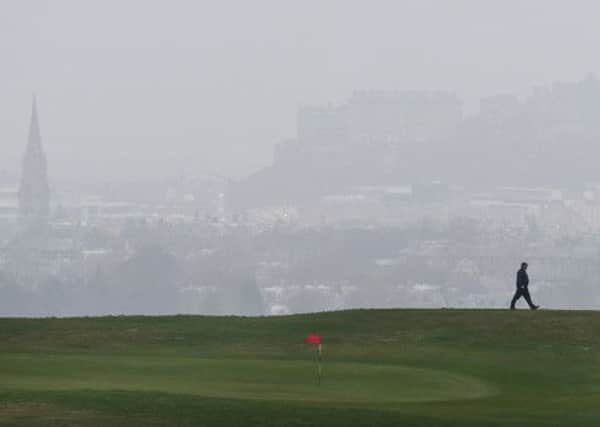999 calls soar as vulnerable choke on smog


Parts of the country experienced record levels of pollution, according to the Department for Environment, Food and Rural Affairs (Defra).
While parts of England were blanketed in thick fog and saw high levels of toxic pollutants, experts said readings in Scotland had not risen above moderate.
Advertisement
Hide AdAdvertisement
Hide AdThe worst-affected areas north of the Border were Wigtownshire, northern Shetland and coastal areas of Fife and the south-east – but none of these spots suffered the high levels of which forecasters warned.
Conditions were predicted to improve today but readings forecast for tomorrow will see South Uist, Barra in the Western Isles, Shetland and coastal areas in the south-east suffer a small drop in air quality.
London and the south-east of England have been experiencing “very high” levels of pollution – the highest recorded by Defra. In total, 19 parts of the UK were in the grip of high levels of pollution, which were given the top grade, a grade ten.
Emergency call-outs for help with breathing difficulties, asthma and heart problems rose by 14 per cent in London.
A storm of dust from the Sahara, emissions from the Continent, low south-easterly winds and domestic pollution has caused air quality to plummet.
The London Ambulance Service said emergency calls for patients with breathing problems yesterday rose from an average of 200 to 227. In parts of southern England, schools banned pupils from playing outdoors to cut exposure to the smog.
West Midlands Ambulance Service and East of England Ambulance Service NHS Trust also reported a spike in calls.
Scottish Ambulance Service said there were no reports of an increase in calls in any part of Scotland as a result of the increased level of pollution.
Advertisement
Hide AdAdvertisement
Hide AdForecasters warned the pollution was due, and yesterday environmentalists criticised Prime Minister David Cameron for calling the haze “a naturally occurring weather phenomenon”.
“It is unpleasant, and you can feel it in the air,” he said. “I didn’t go for my run this morning. I chose to do some work instead. You can feel it. But it’s a naturally occurring weather phenomenon. It sounds extraordinary, Saharan dust, but that is what it is.”
But Green Party European politician Keith Taylor said Mr Cameron’s “flippant response to this invisible killer was utterly disgraceful”.
London mayor Boris Johnson said: “I’m urging people just to have a little balance here. I cycled this morning and it seemed perfectly fine to me.”
Onkar Sahota, London Assembly Labour group health spokesman, described the comments as “dangerously complacent”.
An overnight poll by Asthma UK found nearly a third of sufferers have had an attack as a result of the pollution and 84 per cent reported using inhalers more often than usual.
Kay Boycott, chief executive of Asthma UK, said: “This data demonstrates the current high levels of air pollution are having a significant impact on the health and quality of life of people with asthma and that they need to take urgent action to stay safe.”
Debby Waddell, lead nurse at Asthma UK, added: “We urge all people with asthma to keep a blue reliever inhaler on them at all times and take their preventer inhalers as prescribed.”
Advertisement
Hide AdAdvertisement
Hide AdThose with lung and heart conditions have been told to avoid strenuous activity outdoors while people suffering symptoms of pollution – including sore eyes, coughs and sore throats – should reduce the amount they do outside.
Earth systems scientist Dr Robert Bryant, of the University of Sheffield, warned the effects of global warming could result in similar episodes of extremely poor air quality more often.
“On the face of it, the impact is narrow and short-lived, but the knock-on effects can be unexpected and significant,” he said.
“Strong winds and aridity in Saharan and sub-Saharan Africa are the start. Although some soils are naturally susceptible to wind erosion, unsustainable agriculture due to climate change also loosens the soil.
“The fine soil particles are then whipped into the air as dust and can travel huge distances. En route to the UK, as happened this week, they can combine with European pollutants and then mix with our own.”
World Health Organisation figures show air pollution kills around seven million people globally every year.
Haar today, and gone tomorrow
Visibility was reduced to just a few metres as Edinburgh and other coastal areas in eastern Scotland were shrouded in the type of fog usually seen in warmer months.
Sea haar, a coastal fog that forms over the sea and is carried on to land by the wind, has coated many parts of the south-east of Scotland. It occurs when warm, wet air moves over the cooler North Sea, causing moisture in the air to condense and form haar. Sea breezes and easterly winds bring the haar into the east coast, where it can settle over ground.
Advertisement
Hide AdAdvertisement
Hide AdDr Richard Dixon, of Friends of the Earth Scotland, said: “Haar is quite common in the summer but seeing it for several days this early in the year is quite unusual. Climate change will mean warmer average land temperatures, which are important for haar formation, so there is a good chance we will see more of this.”
A spokesman for the Met Office said the worst of the haar should have disappeared by today, triggered mainly by a change of wind direction.
Smog forecast
Forecasts for pollution are based on quantities of ozone, nitrogen dioxide, sulphur dioxide and harmful airborne particles present in the air, and are graded according to their risk to health.
The forecasts show air quality information on a colour-coded ten-point scale, with “low”, “moderate”, “high” and “very high” brackets to illustrate levels of pollution expected.
Each banding comes with health information for the general public as well as those with conditions that make them extra-sensitive
to air pollution.